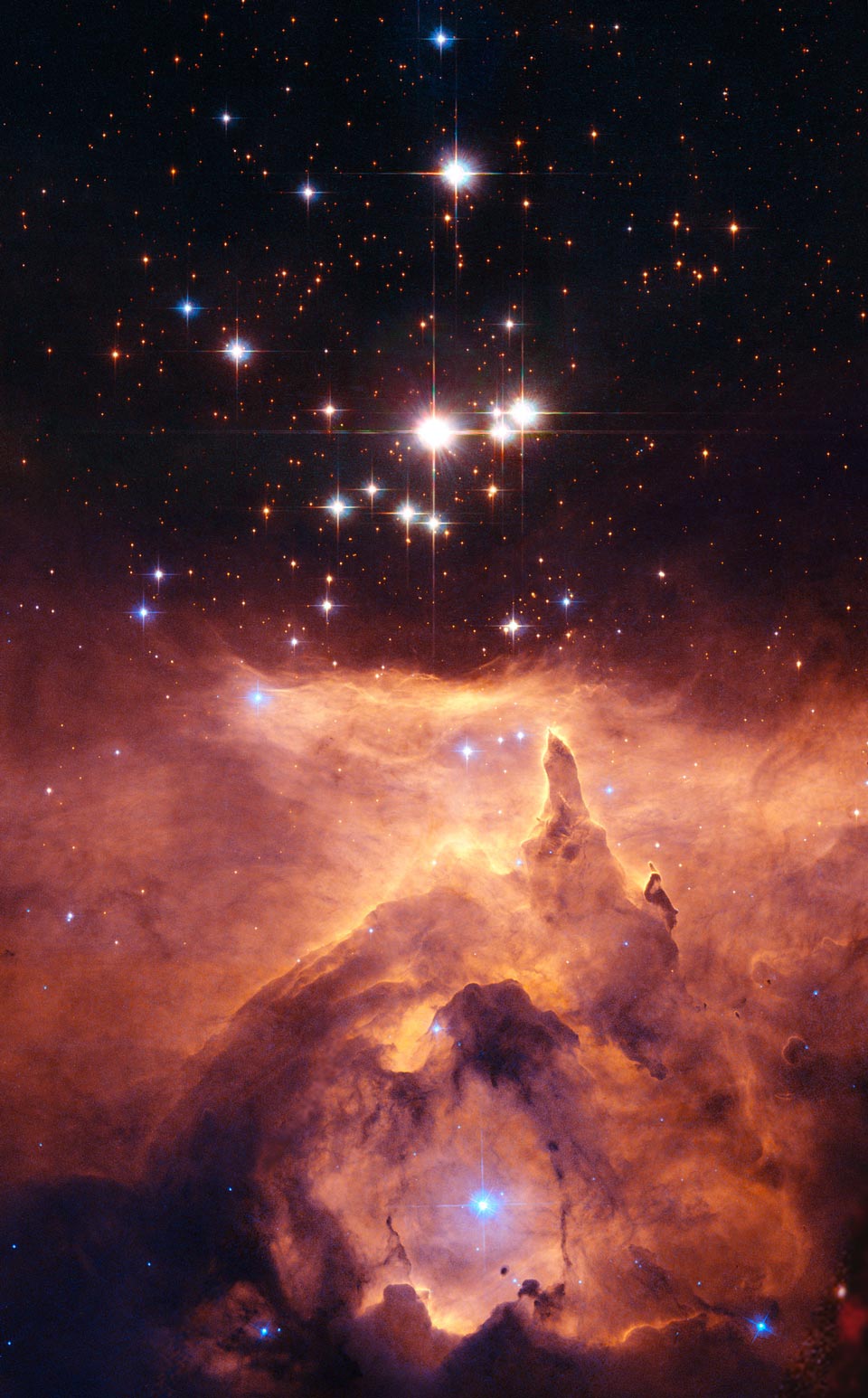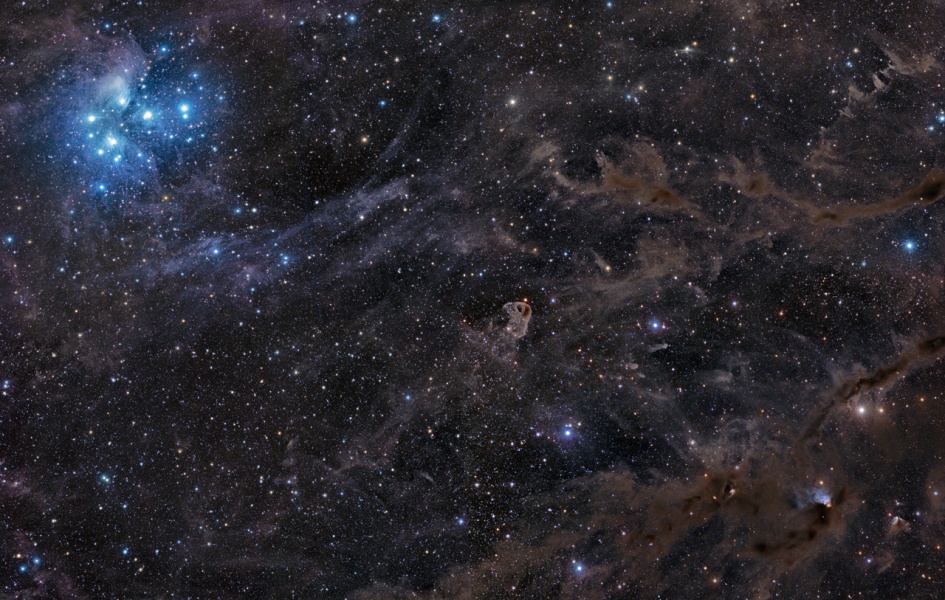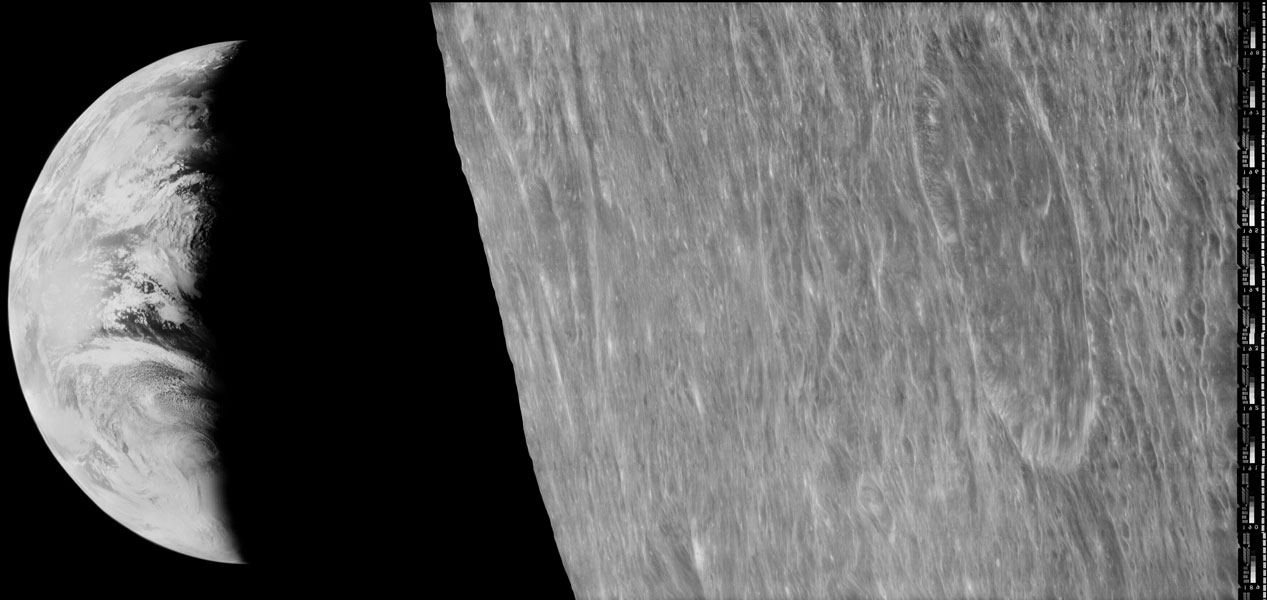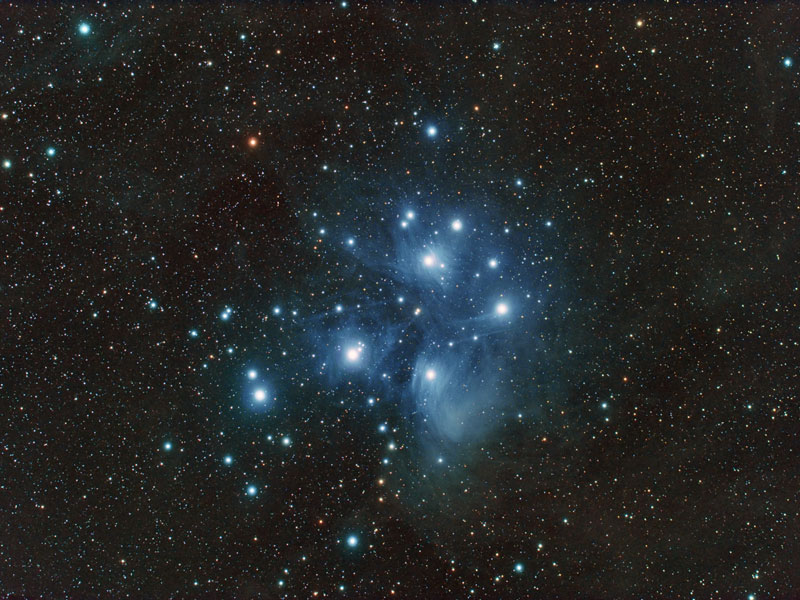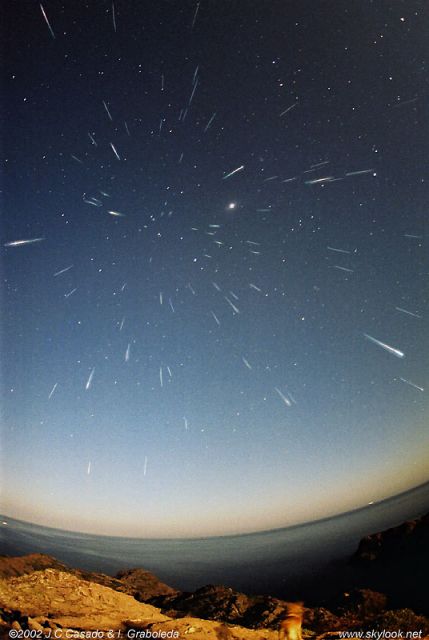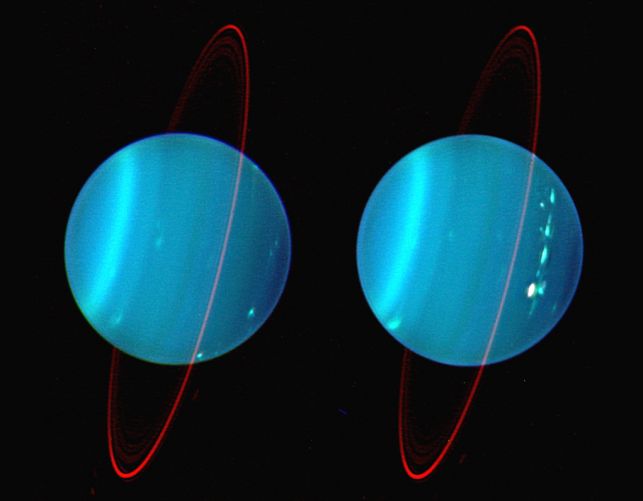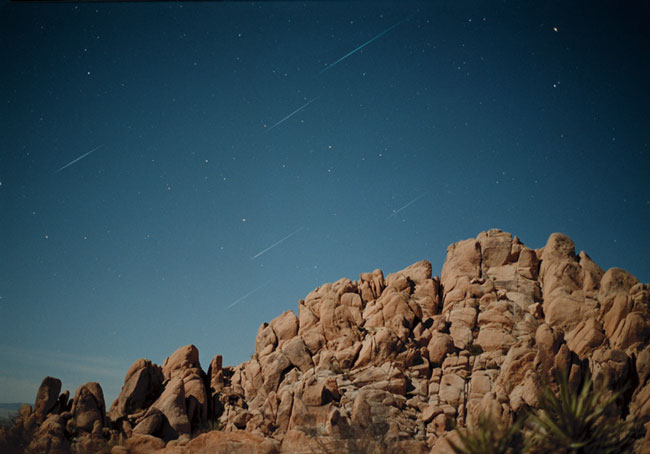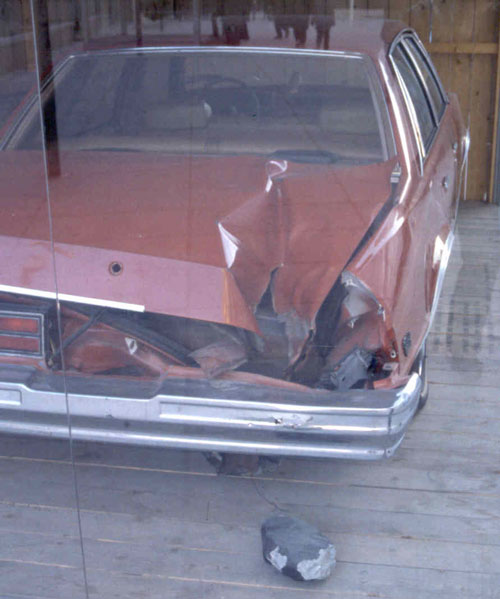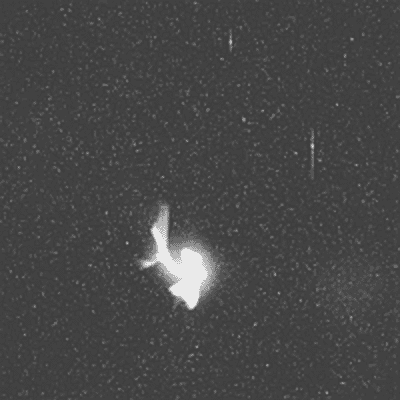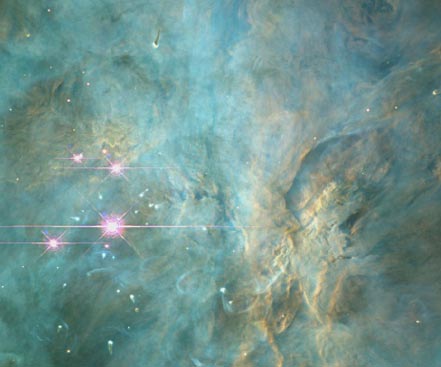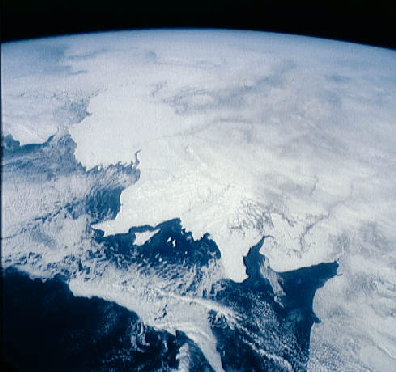| << Previous | Index | Next >> |
2014 Dusty emission in the Tadpole nebula, IC 410, lies about 12,000 light-years away in the northern constellation Auriga. The cloud of glowing gas is over 100 light-years across, sculpted by stellar winds and radiation from embedded open star cluster NGC 1893. Formed in the interstellar cloud a mere 4 million years ago, bright cluster stars are seen all around the star-forming nebula. Notable near the image center are two relatively dense streamers of material trailing away from the nebula's central regions. Potentially sites of ongoing star formation in IC 410, these cosmic tadpole shapes are about 10 light-years long. The featured image was taken in infrared light by NASA's Wide Field Infrared Survey Explorer (WISE) satellite.
2013 What's happening in the sky? On this cold winter night in Iceland, quite a lot. First, in the foreground, lies the largest glacier in Iceland: Vatnajokull. On the far left, bright green auroras appear to emanate from the glacier as if it was a volcano. Aurora light is reflected by the foreground lake Jökulsárlón. On the far right is a long and unusual lenticular cloud tinged with green light emitted from another aurora well behind it. Just above this lenticular cloud are unusual iridescent lenticular clouds displaying a broad spectral range of colors. Far beyond the lenticular is the setting Moon, while far beyond even the Moon are setting stars. The above image was captured in late March of 2012.
2012 How massive can a normal star be? Estimates made from distance, brightness and standard solar models had given one star in the open cluster Pismis 24 over 200 times the mass of our Sun, nearly making it the record holder. This star is the brightest object located just above the gas front in the above image. Close inspection of images taken with the Hubble Space Telescope, however, have shown that Pismis 24-1 derives its brilliant luminosity not from a single star but from three at least. Component stars would still remain near 100 solar masses, making them among the more massive stars currently on record. Toward the bottom of the image, stars are still forming in the associated emission nebula NGC 6357. Appearing perhaps like a Gothic cathedral, energetic stars near the center appear to be breaking out and illuminating a spectacular cocoon.
2011 This colorful topographical map of the Moon is centered on the lunar farside, the side not seen from planet Earth. That view is available to the Lunar Reconnaissance Orbiter though, as the spacecraft's wide angle camera images almost the entire lunar surface every month. Stereo overlap of the imaging has allowed the computation of topographical maps with coverage between 80 degrees north and south latitude. The results have about a 300 meter resolution on the lunar surface and 10 to 20 meter elevation accuracy. Data closer to the north and south poles is filled in using the orbiter's laser altimeter. In this map, white, red, green, and purple represent progressively lower elevations. In fact, the large circular splotch tending to purple hues at the bottom is the farside's South Pole-Aitken Basin. About 2500 kilometers in diameter and over 12 kilometers deep, it is one of the largest impact basins in the Solar System.
2010 Hurtling through a cosmic dust cloud some 400 light-years away, the lovely Pleiades or Seven Sisters star cluster is well-known for its striking blue reflection nebulae. In the dusty sky toward the constellation Taurus and the Orion Arm of our Milky Way Galaxy, this remarkable image shows the famous star cluster at the upper left. But lesser known dusty nebulae lie along the region's fertile molecular cloud, within the 10 degree wide field, including the bird-like visage of LBN 777 near center. Small bluish reflection nebula VdB 27 at the lower right is associated with the young, variable star RY Tau. At the distance of the Pleiades, the 5 panel mosaic spans nearly 70 light-years.
2009 Why is there water on the Moon? Last month, the LCROSS mission crashed a large impactor into a permanently shadowed crater near the Moon's South Pole. A plume of dust rose that was visible to the satellite, although hard to discern from Earth. The plume is shown above in visible light. Last week, the results of a preliminary chemical analysis gave a clear indication that the dust plume contained water. Such water is of importance not only for understanding the history of the Moon, but as a possible reservoir for future astronauts trying to live on the Moon for long periods. The source of the lunar water is now a topic of debate. Possible origins include many small meteorites, a comet, or primordial moon soil.
2008 Pictured above is the first image ever taken of the Earth from the Moon. The image was taken in 1966 by Lunar Orbiter 1 and heralded by then-journalists as the Image of the Century. It was taken about two years before the Apollo 8 crew snapped its more famous color cousin. Recently, modern technology has allowed the recovery of higher resolution images from old data sources such as Lunar Orbiter tapes than ever before. Specifically, recovery of the above image was initiated 20 years ago by Nancy Evans, and completed recently by Dennis Wingo and Keith Cowing who lead the Lunar Orbiter Image Recovery Project. Lunar Orbiter Image Recovery Project. Images like that above carry more than aesthetic value -- comparison to recent high definition images of the Moon enables investigations into how the Moon has been changing.
2007 Perhaps the most famous star cluster on the sky, the Pleiades can be seen without binoculars from even the depths of a light-polluted city. Also known as the Seven Sisters and M45, the Pleiades is one of the brightest and closest open clusters. The Pleiades contains over 3000 stars, is about 400 light years away, and only 13 light years across. Quite evident in the above photograph are the blue reflection nebulae that surround the brighter cluster stars. Low mass, faint, brown dwarfs have also been found in the Pleiades.
2006 This lovely view from northern Spain at Cape Creus on the easternmost point of the Iberian peninsula, looks out across the Mediteranean and up into the stream of the 2002 Leonid meteor shower. The picture is a composite of thirty separate one minute exposures taken through a fisheye lens. Over 70 leonid meteors are visible, some seen nearly head on. Bright Jupiter is positioned just to the right of the shower's radiant in Leo. Perched on the moonlit rocks at the bottom right, Leica, the photographers' dog, seems to be watching the on going celestial display and adds a surreal visual element to the scene. The 2006 Leonid meteor shower will be much less intense than in 2002, but will be near its predicted peak this weekend. Sky watchers will have their best view under dark skies in early morning hours with Leo rising above the eastern horizon.
2005 For the mostly harmless denizens of planet Earth, the brighter stars of open cluster NGC 2169 seem to form a cosmic 37. (Did you expect 42?.) Of course, the improbable numerical asterism appears solely by chance and lies at an estimated distance of 3,600 light-years toward the constellation Orion. As far as galactic or open star clusters go, NGC 2169 is a small one, spanning about 7 light-years. Formed at the same time from the same cloud of dust and gas, the stars of NGC 2169 are only about 8 million years old. Such clusters are expected to disperse over time as they encounter other stars, interstellar clouds, and experience gravitational tides while traveling through the galaxy. Over four billion years ago, our own Sun was likely formed in a similar open cluster of stars.
2004 These sharp views of tilted gas giant Uranus show dramatic details of the planet's atmosphere and ring system. The remarkable ground-based images were made using a near-infrared camera and the Keck Adaptive Optics system to reduce the blurring effects of Earth's atmosphere. Recorded in July, the pictures show two sides of Uranus (careful how you pronounce that ...). In both, high, white cloud features are seen mostly in the northern (right hand) hemisphere, with medium level cloud bands in green and lower level clouds in blue. The artificial color scheme lends a deep reddish tint to the otherwise faint rings. Because of the severe tilt of its rotational axis, seasons on Uranus are extreme and last nearly 21 Earth years on the distant planet. Uranus is now slowly approaching its southern autumnal equinox - the beginning of fall in the southern hemisphere - in 2007.
2003 One year ago today an impressive meteor shower graced the skies of Earth. Pictured above from last year, at least six bright meteors are visible in only part of the sky above Indian Cove campground in California, USA, during a four-minute exposure. The 2002 Leonids packed a double punch with planet Earth plunging through two dense clouds of meteroids, dusty debris left by the passage of Comet Tempel-Tuttle. This year, unfortunately, the main peak of the Leonids Meteor Shower is not expected to be so impressive, with the Earth passing though parts of meteoroid clouds predicted to be much less dense. The main peak of the 2003 Leonids is predicted for tomorrow where some locations might see a bright meteor every minute.
2002 The Peekskill meteor of 1992 was captured on 16 independent videos and then struck a car. Documented as brighter than the full Moon, the spectacular fireball crossed parts of several US states during its 40 seconds of glory before landing in Peekskill, New York. The resulting meteorite, pictured here, is composed of dense rock and has the size and mass of an extremely heavy bowling ball. If you are lucky enough to find a meteorite just after impact, do not pick it up -- parts of it are likely to be either very hot or very cold. In tonight's possibly spectacular Leonid meteor shower, few meteors, if any, are expected to hit the ground.
2001 Last night and tonight, a lucky few may see a meteor explode. As our Earth passes unusually close to debris expelled from Comet Tempel-Tuttle, many sand-sized particles from this comet are entering and burning up in the Earth's atmosphere. This yearly phenomenon is known as the Leonids Meteor Shower, but the location the Earth passes through this year holds promise to provide relatively high activity. In particular, the 1998 Leonids was noteworthy for its many bright meteors. In the above slow-loading sequence, a 1998 Leonid was caught exploding over Los Alamos, New Mexico. In the last one-minute exposure, another Leonid streaks past.
2000 This composite image features classic portraits of members of one of the Solar System's most prominent families - Jupiter and its four large "Galilean" moons. Starting from the top the moons are Io, Europa, Ganymede, and Callisto. The top-to-bottom order is also the order of increasing distance from Jupiter. These are big moons indeed which attend the largest planet. The smallest of the lot, Europa, is the size of Earth's moon while Ganymede is the largest moon in the Solar System. In fact, Ganymede with a diameter of 3,100 miles, is larger than the planets Mercury and Pluto. The swirling Great Red Spot appears at the edge of Jupiter. A hurricane-like storm system that has persisted for over 300 years, two to three earths could fit inside it. Battered Callisto's image was recorded during the 1979 flyby of Voyager. The other portraits were taken by the Galileo spacecraft which began exploring the Jovian system in 1995.
1999 In the sky or on the web, did you watch this year's Leonid meteor shower? If you did, meteors flashing through the night sky should be a familiar sight. Recorded last year during the 1998 apparition of the Leonids, this time-exposure of the sky around the constellation Canis Major (big dog) shows the trail of a spectacular fireball meteor. The meteor, by chance, seems to leap from the constellation's brightest star Sirius, near the top right. In the foreground is the beautiful desert scenery of Joshua Tree National Park. At this year's peak of the cosmic dust storm, observers in Europe and Africa reported intense rates of over 1600 meteors per hour for a brief period near 0215 November 18 (UTC). Awe inspiring as they were, the Leonids posed no danger to earthbound skywatchers.
1998 It's the bubble versus the cloud. NGC 7635, the Bubble Nebula, is being pushed out by the stellar wind of massive central star BD+602522. Next door, though, lives a giant molecular cloud, visible above to the upper left. At this place in space, an irresistible force meets an immovable object in an interesting way. The cloud is able to contain the expansion of the bubble gas, but gets blasted by the hot radiation from the bubble's central star. The radiation heats up dense regions of the molecular cloud, causing the orange glow seen above. The Bubble Nebula is about 10 light-years across and part of a much larger complex of stars and shells. The Bubble Nebula can be seen with a small telescope towards the constellation of Cassiopeia.
1997 Start with the constellation of Orion. Below Orion's belt is a fuzzy area known as the Great Nebula of Orion or M42. In this nebula is a bright star cluster known as the Trapezium, shown above. New stellar systems are forming there in gigantic globs of gas and dust known as Proplyds. Looking closely at the above picture also reveals that gas and dust surrounding some of the dimmer stars appears to form structures that point away from the brighter stars. The above false color image was made by combining several exposures from the Hubble Space Telescope.
1996 Something strange happened to this galaxy, but what? M82 is a nearby galaxy in the group of galaxies dominated by itself, M81, and NGC 3077. M82 is thought by some to be limping away from a close encounter with M81. This galactic collision might have stirred up the inner stars and gas in M82, causing the unusual dark lanes of dust visible in the above photograph. M82 is a starburst galaxy with a very active center containing star clusters far brighter than any in our own Milky Way Galaxy.
1995 Water (Dihydrogen Oxide, H2O) is a truly remarkable chemical compound and is fundamental to life on Earth. Earth is the only planet in the Solar System where the surface temperature and pressure allow the three forms of water, solid (ice), liquid (ocean), and gas (water vapor condensing in clouds) to exist simultaneously on its surface. Water in one of these forms accounts for everything visible in this view of Earth from space looking north at the Bering Sea and the coast of Alaska, USA, around Bristol Bay.
| << Previous | Index | Next >> |


